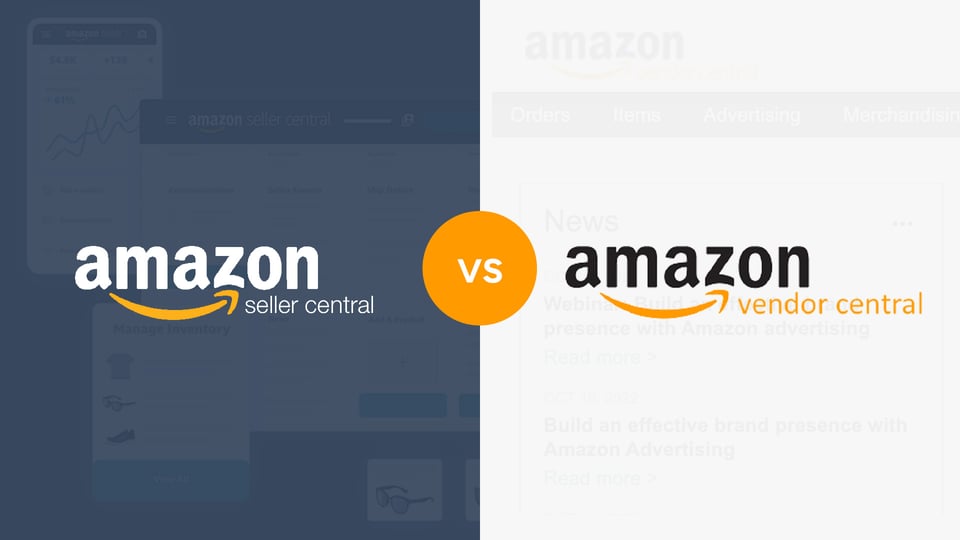Selling on Amazon is now almost essential for all consumer brands unless you want to miss out on a huge cohort of consumers. If you're looking to sell on Amazon, you have two main ways to do it. Use Amazon Seller Central or Amazon Vendor Central. Each platform provides its advantages and disadvantages.
This article will look at both platforms, their respective benefits for businesses looking to sell products through them, and how best to set up one of them.
Before delving deeper, let's understand the difference between Seller Central and Vendor Central.
What is Amazon Vendor Central?
Amazon Vendor Central is the platform used by first-party sellers (1P) who sell directly to Amazon. Vendor Central is an invite-only program where Amazon purchases products directly from manufacturers and authorized distributors, eliminating intermediaries. Vendors supply their product(s) directly to Amazon, and Amazon handles selling, pricing, and customer service responsibilities on your behalf. This arrangement is often referred to as first party (1P).
Amazon's Vendor Central Recruitment team seeks out potential new vendors among established Seller Central sellers, marketplace sellers with popular products, and trade show exhibitors with unique offerings. If your products catch their attention, Amazon may extend an invitation for Vendor Central membership.
Imagine an established electronics manufacturer that produces cutting-edge gadgets and electronic devices and has garnered an excellent reputation within its industry due to its innovative products and quality assurance processes. One day, they receive an invitation from Amazon's Vendor Central program.
The manufacturer is a Vendor Central participant and sells its electronic products directly to Amazon, bypassing intermediaries and forging direct partnerships with one of the largest ecommerce platforms globally. This streamlines their distribution process while creating direct partnerships with one of the world's biggest ecommerce platforms.
The Pros & Cons of Amazon Vendor Central
Pros:
- Bulk orders from Amazon: Amazon buys your products in large quantities and manages everything from fulfillment to customer service.
- A+ content: Vendor Central offers A+ Content tools, allowing you to create rich, detailed product descriptions that can enhance conversions.
- Amazon's credibility: Being listed as "Sold by Amazon" can build customer trust and credibility, increasing the likelihood of sales.
- Loss of pricing control: Amazon determines your product prices, and any discounting could significantly impact your margins.
- Limited flexibility: Vendor Central offers fewer opportunities to control your brand presentation, promotions, and customer relationships.
Getting started on Amazon Vendor Central
1. Invite or Apply: Vendor Central is invitation-only. Amazon will typically email you that they are interested in selling your products.
2. There is not usually much scope for negotiating terms unless you are a large brand. Amazon will provide you with the terms.
3. Product Setup: Amazon will walk you through the steps to create product listings and provide essential details. Amazon's system considers sales history and current demand before determining if an order should be placed.
4. Shipping and Billing: Amazon will communicate with you regarding order quantities, shipping details, and billing.
Amazon Marketing Services offers the tools necessary to promote and increase visibility for your products on Amazon Marketplace.
While Amazon Vendor Central provides the advantage of bulk orders and Amazon’s extensive distribution network, it can be challenging for vendors to maintain flexibility and control over their products. If you’re looking for a way to streamline and optimize your vendor operations, ChannelEngine's Vendor Hub can help.
With Vendor Hub, you can integrate directly with Amazon and other leading marketplaces, allowing you to manage your product listings, orders, and pricing across multiple platforms. It provides the flexibility to adapt to marketplace changes and ensures your business stays in control while benefiting from Amazon’s extensive reach. Our solution simplifies the complexities of Vendor Central, making it easier to scale your ecommerce operations globally.
What is Amazon Seller Central?
Seller Central is Amazon's platform that enables individuals and businesses to list and sell products directly to its massive customer base, acting as a third-party seller on Amazon with control over inventory, pricing, and customer interactions - an attractive proposition for startups and established brands alike. Amazon's selling partner volume is around 2 million as of March 2023.

Imagine that "Crafty Creations", a small craft store offering handmade, unique, and artisanal products like handmade jewelry, personalized home decor items, and customized gifts, has decided to use Amazon Seller Central to expand its customer reach and tap into Amazon's vast customer base.
Crafty Creations uses Amazon Seller Central to list their products directly on Amazon's platform and gain control over inventory management, pricing strategies, and customer interactions. The business can leverage Fulfilled by Amazon (FBA) for efficient order fulfillment and customer service, though this approach can compromise brand control to some degree. "Crafty Creations" protects its profit margins by opting for direct sales, which enables it to set its price, rather than selling wholesale to Amazon. They can offer personalized shopping experiences while keeping their brand intact within the Amazon marketplace.
The Pros & Cons of Amazon Seller Central
Pros:
- Control over pricing: As a seller, you maintain control over your product pricing, which allows you to set your margins and run promotions as you see fit.
- Direct customer relationships: Seller Central allows you to handle customer interactions directly, offering valuable insights into buyer preferences and behaviors.
- Flexibility in branding: With access to Enhanced Brand Content and Amazon Advertising, you can shape how your products are presented and promote them effectively.
- Agility: You can quickly adjust listings, prices, and promotions without waiting for Amazon’s approval.
- Increased operational responsibility: Sellers need to manage customer service, returns, and order fulfillment, which can be resource-intensive if you're not using FBA.
- Competition: Seller Central has a large pool of third-party sellers, which increases competition and makes it more challenging to stand out.
Getting started on Amazon Seller Central
1. If you don't already have one, sign up for an Amazon account.
2. Choose an Individual or Professional Selling Plan: Depending on your business's scale and anticipated sales volume, determine an Individual or Professional selling plan to help guide sales efforts.
3. List Your Products: List your products by providing details, pricing information, and images.
4. Fulfillment Method: Determine whether you'd prefer fulfilling orders yourself (FBM) or using Amazon's fulfillment services (FBA).
5. Once Your Listings Are Live: Once your listings are live, you can begin selling and managing orders with Seller Central.
Recent trends & considerations
As the marketplace landscape continues to evolve, it's essential to stay informed about the latest trends and shifts that can impact your selling strategy on Amazon.
In recent years, growing competition on Vendor Central has made it increasingly difficult for brands to stand out. As more businesses sign up for Vendor Central, the platform has become saturated, which has led to a more crowded marketplace. This intense competition, combined with Amazon's control over pricing and the limitations on branding, has prompted many sellers to shift their focus to Seller Central. On Seller Central, businesses maintain greater control over their pricing strategies, allowing them to protect their margins and run targeted promotions. Sellers also have access to more robust branding tools like Enhanced Brand Content and Amazon Advertising, enabling them to craft a stronger, more distinct brand presence.
Moreover, Amazon's evolving terms and policies continue to impact Vendor Central sellers. As Amazon adjusts its vendor agreements and product requirements, many businesses find it challenging to keep up with the frequent changes. These evolving terms can affect everything from order quantities to payment terms, making it crucial for vendors to stay informed. As a result, many sellers are re-evaluating their use of Vendor Central and opting for a more hybrid or Seller Central-focused approach to retain flexibility and control.
With these recent trends in mind, understanding the advantages of Seller Central versus Vendor Central becomes even more crucial for developing the right approach for your business.
Advantages of Seller Central over Vendor Central
- One of the primary advantages of Seller Central for sellers is its level of control. As an individual seller, you have full authority to set prices, manage inventory levels, and communicate directly with customers - which is particularly advantageous in maintaining your brand identity and customer relationships.
- Access to an Expanded Selection: Seller Central allows you to list a comprehensive range of products, from unique or niche items through mainstream offerings. This feature makes Seller Central ideal for businesses that offer multiple product lines.
- Seller Central provides access to businesses of all kinds, from individuals selling handmade crafts online to established companies with established presences. The relatively low entry barrier makes Seller Central an attractive option for startups and small businesses.
- Sellers can select between Fulfilment by Amazon (FBA) or Fulfillment by Merchant (FBM). FBA provides sellers with convenient shipping, customer service, and returns management from one convenient source.
Advantages of Vendor Central over Seller Central
- Amazon will handle order processing, customer service, and returns so that your company can focus on manufacturing and distributing its products.
- A suite of advertising tools and resources can help boost visibility and sales, allowing vendors to promote their products effectively.
- By selling products through Vendor Central as a first-party seller, customers will likely feel assured when placing orders through Amazon rather than third-party sites with lesser name recognition.
- Vendor Central offers businesses that can quickly fill large orders an opportunity to sell in bulk to Amazon, making Vendor Central an attractive platform.
- Vendor Central on Amazon allows sellers to participate in promotional programs such as Subscribe & Save and Amazon Vine, sending products directly to top reviewers for user-generated reviews that build brand trust while increasing sales due to consumer input on product quality.
Hybrid Selling: Best of both worlds
More businesses are adopting a hybrid selling approach, using both Seller Central and Vendor Central to balance control with volume sales.
Benefits of Hybrid Selling:
- Flexibility and scale: Maximize your reach by tapping into both wholesale and direct sales.
- Strategic control: Use Vendor Central for high-volume, lower-margin products while keeping high-margin or niche products in Seller Central.
- Broader customer reach: Optimize for different customer segments by leveraging the strengths of both platforms.
Final words
At its core, choosing between Amazon Seller Central, Vendor Central, or a hybrid selling approach depends on your business goals, resources, and how much control you want. Seller Central offers more control over pricing, branding, and customer relationships, while Vendor Central simplifies operations but is invite-only and comes with certain restrictions. Before deciding, assess your current needs, resources, and future growth potential. Keep in mind, you can always adjust and refine your strategy as your business evolves.





